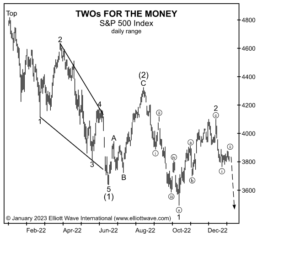Prechter on Stocks
The U.S. stock market has not yet reached the halfway point of the bear market. The decline is poised to accelerate in 2023. Near term, a countertrend rally from mid-October ended at the December 13 intraday highs in the Dow Industrials, S&P 500 and NASDAQ 100.
As the Socionomist explained in an August 2009 study of Wave-Principle dynamics, third waves mark the time when psychology flips. When wave (3) down passes its center point, the widespread feeling of ebullience will morph into a feeling of deep pessimism. Third-wave declines are watershed moments at all degrees. This is the psychological “point of recognition” within an impulse when people are no longer net optimistic but start to become net pessimistic. An emerging exasperation with the downtrend in financial markets has appeared in recent months (see December issue, p.6). This frustration will become more pronounced as the stock market progresses closer to the mid-point of wave 3 of (3), at which time annoyance will “suddenly” turn into fear. The developing wave structure has kept us market bears patient, waiting for this point in the developing decline. This patience should be rewarded in the months ahead.
The S&P 500 is a hybrid between the Dow and NASDAQ, comprising the blue-chip stocks of the Dow as well as the more speculative shares of the NASDAQ. Minor wave 2 up of Intermediate wave (3) down took the form of a zigzag and peaked at a close of 4080.11 on November 30 and intraday at 4100.96 on December 13. The decline from December 13 to December 22 is an impulse, which we label Minute wave 1 of Minor wave 3 of Intermediate wave (3). Like the NASDAQ, the S&P is moving toward the point of increasing downside speed.

So is his commentary invalidated since the market went 180 degrees opposite to what he depicted in the drawing?
I am sympathetic to his views, however psychology seems to actually be improving as a result of the price action.
Not invalidated yet. The market sits currently at 4000. It would take a rise above the wave 2 high to change the count, and a rise above the wave (2) high to further erode the bear case.
Prechter took Hamilton and Elliott’s work and added Psychology and Sociology. Great stuff. But the wave counting part is still nearly impossible to get right, since at every juncture the options you have going forward depend on having the ENTIRE past counted correctly, given the rules and guidelines.
Others in EW land say you shouldn’t use EW on its own, and need external benchmarks for validation, and I subscribe to that. I don’t use EW at all for analytics, except as a communication tool.
Joe Taverna at studyofcycles is very good, emphasizing instruction. He sees a local correction here, then one more set of highs, into a top near end of month. That seems possible to me. But Joe’s forward guidance when he offers it isn’t as sharp as one might hope for, illustrating the pitfalls of trading purely off theory.